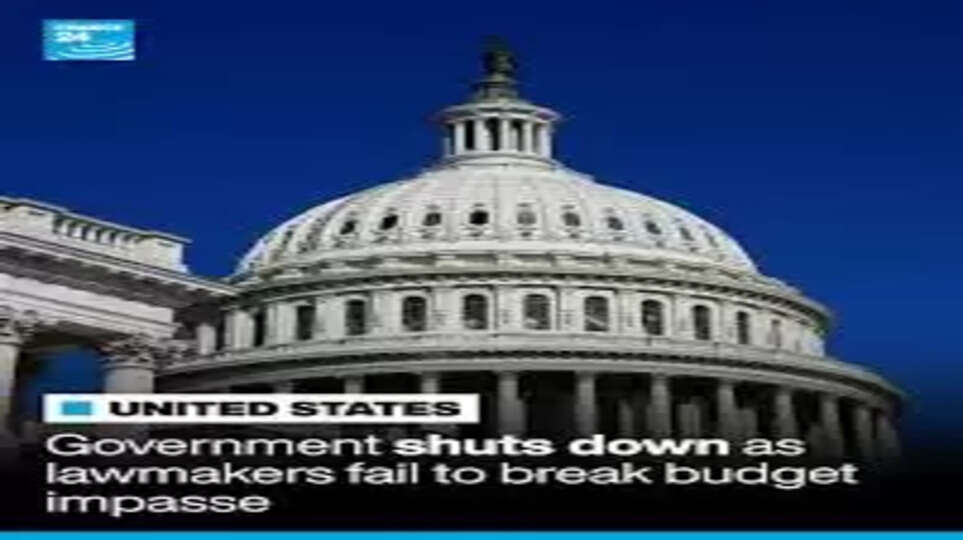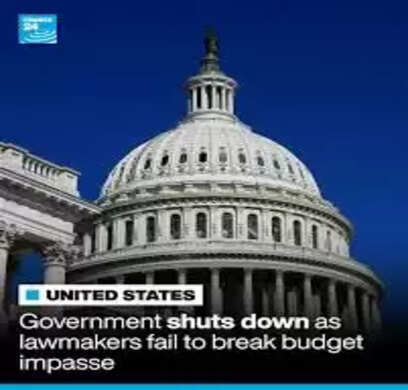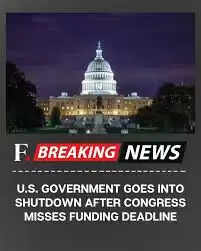The Budget Battlefield: Unpacking the US Federal Government Shutdown and Its Far-Reaching Impact
The ongoing U.S. federal government shutdown, triggered by deep partisan budget impasses over healthcare and federal spending, has furloughed hundreds of thousands of workers and disrupted critical services. Explore the core political sticking points, the profound economic and social costs, and the outlook for an end to the crisis.


Introduction
The United States federal government is currently mired in a shutdown, a stark demonstration of Washington's inability to resolve deeply entrenched budget impasses. Non-essential government operations ground to a halt on October 1, 2025, after Congress failed to pass appropriations legislation for the new fiscal year. This fiscal paralysis is more than a mere administrative inconvenience; it represents a high-stakes political standoff with severe real-world consequences, immediately impacting the lives and livelihoods of nearly a million federal workers and disrupting crucial services for millions of Americans.
At its core, the current gridlock is fueled by significant partisan disagreements over federal spending levels, specifically the future of key healthcare subsidies and substantial cuts to programs like Medicaid introduced earlier in the year. With key agencies partially or fully suspended, from crucial public health initiatives to loan approvals for small businesses, the pressure is mounting on lawmakers to find a resolution that has so far proven elusive. This article will delve into the root causes of the shutdown, examine the contentious issues at the heart of the budget dispute, and analyze the disruptive economic and social impacts that grow more severe with each passing day.
The Political Flashpoint: Core Issues Driving the Impasse
The immediate cause of the 2025 federal government shutdown is Congress's failure to pass all 12 annual appropriations bills or a short-term Continuing Resolution (CR) to keep the government funded past the October 1st deadline. However, the root cause lies in fundamental partisan disagreements, primarily centered on healthcare policy and the executive branch's fiscal authority.
The most significant sticking point is the expiration of enhanced subsidies for the Affordable Care Act (ACA) marketplace, originally expanded during the pandemic. Democrats are demanding that any deal to reopen the government must include a permanent extension of these premium tax credits. The expiration of these subsidies is projected to significantly increase health insurance premiums for millions of Americans, making the issue a central political battleground.
A second major point of conflict stems from provisions within the "One Big Beautiful Bill Act" passed earlier in 2025. This legislation included substantial cuts to federal programs, most notably Medicaid, which provides health insurance to low-income Americans. Democrats are pushing to repeal or reverse these significant reductions as part of a funding resolution, arguing they will harm the most vulnerable populations.
A third contentious issue relates to the executive branch's use of "rescissions" to cut congressionally appropriated funding. Democrats are seeking provisions in any new funding bill that would limit the White House's ability to unilaterally withhold or impound funds that Congress has previously approved for specific programs, a move that speaks to a broader constitutional struggle over the "power of the purse."
The political environment surrounding the budget debate is characterized by hardline positions. Congressional Republicans, holding a majority, initially sought a "clean" continuing resolution to extend funding at existing levels until November 21, without the inclusion of the Democratic-sought healthcare provisions. Democrats, however, have refused to approve any funding that does not address the looming healthcare cost increases and Medicaid cuts, leaving no path to the 60 votes required to pass a bill in the Senate. This political trench warfare, where neither side is willing to concede on their core policy demands, is what ensures the government remains shuttered.

Immediate and Growing Impact on Federal Workers
One of the most direct and profound consequences of the shutdown is the immediate financial and professional disruption to the federal workforce.
Roughly 900,000 federal employees have been furloughed, meaning they are temporarily laid off without pay and prohibited from working. These workers are classified as "non-essential" and must wait for Congress to pass an appropriations bill before they can return to their jobs and eventually receive back pay, a guarantee that has become a point of political uncertainty.
Another 700,000 federal employees are classified as "excepted" or "essential" and are required to continue working without pay. This group includes critical personnel vital to protecting life and property, such as Transportation Security Administration (TSA) agents, air traffic controllers, border patrol agents, and military personnel. While military pay may be covered temporarily through redirected funds, these employees face the stress of missing their first paychecks while being legally obligated to continue their demanding duties.
The financial strain on federal workers and their families begins almost immediately. Missing a paycheck can trigger a cascade of economic hardship, affecting everything from mortgage and rent payments to utility bills and childcare costs. The uncertainty over receiving back pay—a promise that President Trump has raised questions about—adds a significant layer of anxiety, eroding morale and potentially leading to an increase in sick calls or resignations among critical staff.
Beyond the immediate pay issue, a prolonged shutdown impacts the long-term health of the federal workforce. It halts all non-essential hiring and training, exacerbating existing staffing shortages in key areas like air traffic control. Furthermore, a White House Office of Management and Budget memo suggesting agencies prepare for "reduction in force" (mass layoffs) rather than simply furloughs signals a potentially permanent and damaging restructuring of the federal government that goes far beyond the typical temporary nature of a shutdown.
Economic Disruptions Ripple Across the Nation
The federal government shutdown has significant and immediate macroeconomic consequences, with economists estimating a loss to the U.S. economy of billions of dollars per week.
The suspension of services at key agencies creates a drag on economic activity. The U.S. Small Business Administration (SBA) has ceased accepting, reviewing, or approving new business loans and loan guarantees, immediately affecting entrepreneurs and small businesses reliant on this federal financing. Similarly, the Federal Housing Administration (FHA) has stopped approving applications for housing loans, creating major delays in development, rehabilitation, and refinancing of properties, which can stall the real estate market.
The shutdown also introduces significant uncertainty into financial markets by delaying the release of crucial economic data. Agencies like the Bureau of Labor Statistics and the Census Bureau stop publishing key reports, such as the monthly jobs report, which the Federal Reserve and financial analysts rely on to make informed decisions on interest rates and investment. This data blackout can cloud the economic outlook and complicate monetary policy decisions.
Furthermore, the lack of federal funding impacts a vast network of government contractors. Stop-work orders are issued for non-essential contracts, leading to significant delays and financial insecurity for private companies and their employees who rely on government business. The longer the shutdown lasts, the greater the disruption to the industrial base and the more likely it is that contractors will seek to "pad" future contracts to cover for the risk of future payment interruptions, a cost ultimately borne by the taxpayer.
Critical Services and Social Programs Under Stress
While core mandatory spending programs like Social Security, Medicare, and Medicaid continue to issue payments, the administrative functions, processing of new enrollments, and customer service for these vital programs can be significantly delayed or halted due to furloughed staff.
The Special Supplemental Nutrition Program for Women, Infants, and Children (WIC), which provides food assistance to millions of low-income mothers and children, faces an imminent funding crisis. Although the administration has attempted to use tariff revenue as a temporary stopgap, the program's long-term stability is jeopardized by the lack of congressional appropriation, threatening the nutritional security of vulnerable families.
Services for veterans, while generally maintaining healthcare at VA facilities, see non-essential functions paused. Medical and prosthetic research is furloughed, and the oversight and direct administration of various veterans' benefit programs are put on hold.
Public health initiatives are also severely curtailed. Agencies like the National Institutes of Health (NIH) and the Centers for Disease Control and Prevention (CDC) face partial or full suspensions of operations, disrupting ongoing medical research, disease surveillance, and public health communications at a critical time.
The disruption extends to public spaces and travel. National Parks and Monuments are either fully closed or remain open with minimal staffing, leading to limited services, a lack of trash cleanup, and potential public safety hazards. In air travel, while air traffic controllers and TSA agents are working, staffing shortages and increased sick calls due to unpaid labor lead to longer security lines and intermittent flight delays at major airports, a situation likely to worsen the longer paychecks are missed.
FAQ's: Addressing Key Concerns About the Shutdown
Q: What is the main issue preventing Congress from ending the government shutdown?
The main issue is the impasse between Democrats and Republicans over healthcare. Democrats are demanding an extension of the expiring Affordable Care Act (ACA) premium tax credits and the reversal of recent major cuts to Medicaid as a condition for reopening the government. Republicans are generally insisting on a "clean" funding bill that keeps spending at current levels without addressing these policy demands until after the government is reopened.
Q: Are federal employees getting paid during the shutdown?
No. Federal employees classified as "non-essential" (furloughed workers) are temporarily laid off and will not receive paychecks during the shutdown. "Essential" or "excepted" employees, such as TSA agents and air traffic controllers, are required to work but are also not receiving pay. Historically, furloughed and excepted workers have received back pay once the government reopens, but an administration memo questioning the guarantee of back pay has introduced new uncertainty.
Q: Will my Social Security or Medicare payments stop?
No. Social Security, Medicare, and Medicaid payments are generally considered mandatory spending, funded through trust funds or permanent appropriations. Therefore, the scheduled benefit payments will continue to be disbursed during the shutdown. However, administrative functions, new enrollments, and customer service at these agencies may be significantly delayed due to reduced staffing.
Q: What is the economic cost of the shutdown?
Economists estimate the shutdown is costing the U.S. economy billions of dollars per week in lost output and consumer spending. This includes losses from furloughed workers not being paid, the suspension of services like small business loans and housing loan approvals, and the general uncertainty that delays investment and slows down business activity.
Q: Are National Parks and Monuments closed?
Operations vary by park, but many National Parks and Monuments are either fully closed or operating with significantly reduced staffing. Visitor centers, restrooms, trash collection, and maintenance services are often suspended or extremely limited, leading to potential health and safety issues for visitors.
Q: How does the shutdown affect air travel?
While air travel continues, the shutdown affects personnel at the Transportation Security Administration (TSA) and the Federal Aviation Administration (FAA), including air traffic controllers. These essential employees are working without pay, leading to reports of increased sick calls and staff shortages. This can result in longer security lines, intermittent flight delays, and a potential, but unconfirmed, risk to safety if the situation persists and staffing levels drop further.
Conclusion
The 2025 U.S. federal government shutdown is not a mere bureaucratic hiccup but a profound political crisis with rapidly accelerating national consequences. Driven by irreconcilable partisan demands over healthcare subsidies, Medicaid funding, and the executive's spending authority, the budget impasse has translated into immediate financial hardship for hundreds of thousands of federal workers and significant disruption to critical public services. From stalling small business loans to jeopardizing nutrition assistance programs and impacting the efficiency of air travel, the shutdown's economic and social ripple effects are far-reaching. The longer Congress remains unable to bridge the political chasm, the greater the irreversible damage will be to the federal workforce, the nation's economy, and the overall trust in government institutions. A resolution will require one or both sides to step back from their maximalist positions and prioritize the functioning of government over political victory.
